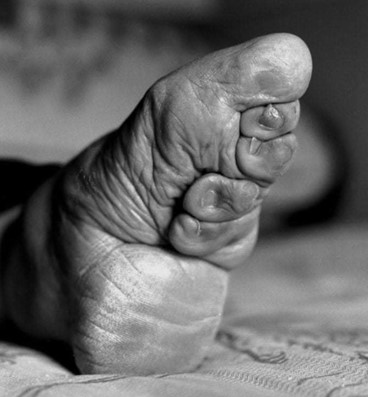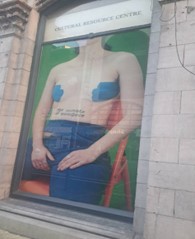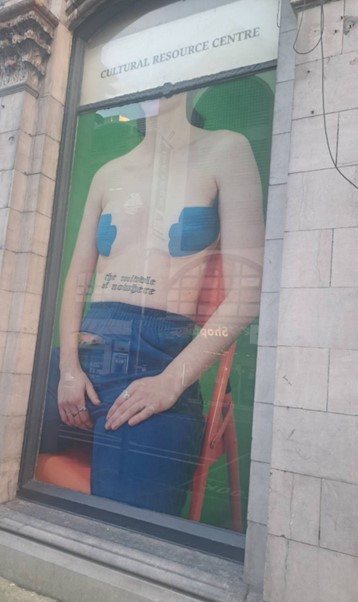The Chinese custom of foot binding involved tightly binding the feet of young girls to achieve a small, severely deformed foot, considered a symbol of beauty, status, and desirability, in addition to being associated with the idea of a woman’s place being in the home. The process involved folding the toes under the sole and wrapping them tightly with cloth or ribbons, causing lifelong physical deformities, pain, and mobility issues. It is now widely recognized as a harmful and painful tradition and is no longer practised.

Foot binding is just one example of the extreme measures that societies have taken to enforce gender norms and “beauty” standards. Nowadays, girls wishing to escape the expected female gender norms in terms of appearance and behaviour are sold the lie that they can simply change sex. Ironically, the first step in achieving this goal is usually breast binding, where a young woman compresses her breasts by wearing a tight garment called a binder, or by taping her developing breasts, to achieve a flatter, more masculine shape. In addition to being largely ineffective in changing one’s appearance sufficiently to pass as a man, the practice has long-term harmful physical consequences, as outlined here by Tracy Donegan, R.M of The Countess healthcare working group.
WHAT IS BREAST/CHEST BINDING AND IS IT SAFE?
Following on from our article on elective mastectomies, we now explore the concept of breast binding or taping, a recent trend that is often the first step towards surgical removal of the breasts. Breast/chest binding involves the painful compression of breast tissue in developing teenage girls, flattening the silhouette in an attempt to conceal visible signs of femaleness. It has been compared to the harmful Chinese practice of foot binding, a painful tradition which significantly limited the mobility of women and resulted in lifelong disabilities. While the exact origin of foot binding is unknown, some suggest that it began because of male erotic fascination with the shape of court dancers’ feet while dancing. Foot binding has been compared to other ways of “perfecting” the female body, such as corsets and female genital mutilation (FGM).
Breast binding, on the other hand, is something young women are choosing to do themselves, often without the knowledge of their parents, in order to escape from female gendered expectations.
If you are a young woman who is considering breast binding, or a parent, there are several important aspects to consider.
In the process of binding, some girls may over-compress their breasts to get quicker results in an attempt to “pass” (appear to be male or non-binary/no sex). One of the major risks of breast binding is bruised or broken ribs, which can create a domino effect of further health problems such as puncturing or collapsing a lung. Compressing the chest can also permanently damage small blood vessels around the ribs, leading to inflamed ribs (costochondritis). Compression of the lungs and a restriction of the ability of the lungs to naturally inflate and deflate can result in shortness of breath, reduced exercise tolerance and even a buildup of fluid in the lungs. Decreased blood flow to the heart can lead to heart complications. There are additional risks during pregnancy, because of hormonal changes affecting connective tissue, which may intensify painful rib flare. Tight binding of the breasts in pregnant women can also increase breast sensitivity, while decreased oxygenation of the blood results in decreased oxygen available to the unborn baby.
Skin issues resulting from friction from the binding and lack of circulating blood to the tissues may cause nipple tissue to become inflamed and infected, leading to permanent scarring and nerve damage. Some teens are even reporting disintegration of their nipples due to wearing unsuitable compression garments for long periods (even during sleep). Other side effects include bacterial and fungal infections and other skin conditions because the skin cannot “breathe”.
Additionally, teens with pre-existing medical conditions, including asthma, scoliosis, lupus, and fibromyalgia, are at greater risk of complications.
Neurological issues linked to breast binding include dizziness and headaches due to overheating and lack of circulating oxygen. Long term use is also associated with loss of muscle mass and changes in posture.
Columbia University reports the following risks. “Many people [sic] also adopt a slumped posture in an effort to hide their breasts, which might make it harder to breathe easily and result in possible headaches and back pain. Over time, continued breast binding can make breast tissue elongated and more malleable, actually making compression easier. However, studies indicated that people who bound their breasts more frequently were more likely to report negative health effects.”
However, Columbia University also offers this advice: “It’s not recommended for providers to consider the physical effects over the mental health effects unless the binding is causing severe injury.” In other words, if a young woman feels emotionally happier, then providers (and parents) should ignore the potential physical complications caused by breast binding. Maybe before ordering that binder, therapy with an experienced professional would be helpful for young women who are willing to endure so much physical and emotional pain to fit in. It is worth noting that a significant percentage of young women who choose to identify as male are on the autism spectrum. Women on the spectrum report more difficulty picking up social signals, including those social signals around gendered expectations. This can leave them feeling alienated and vulnerable to becoming a target when they fail to meet the social expectations of their peers, particularly during the teen years.
Because so many mainstream institutions have aligned themselves with gender ideology, it can be difficult to find unbiased information.
Most of the available information warns parents that access to binders is “critical to their child’s mental health”.
It would be bizarre for healthcare professionals to affirm someone suffering from any other form of discomfort with one’s body, such as anorexia, and encourage them to take whatever measures they deem necessary to reduce their distress (including diet pills and starvation). While access to diet pills can make teens with anorexia feel aligned with their body image and reduce emotional distress, healthcare professionals try to find a balanced form of treatment that aims to both address the underlying issues and maintain physical health.
BREAST TAPING

A recent addition in this damaging body modification trend is the use of kinetic tape (K-tape), also known as “trans tape”, a form of elastic sports tape that people use to support their joints and muscles. However, manufacturers do not design it for chest compression. A quick look at the “transtape” website has many parents justifiably concerned https://transtape.life/
CASE STUDY
A recent case study describes an unexpected risk observed in a woman who experienced a life-threatening complication during an endoscopy, which is a relatively simple procedure where a thin tube with a camera is inserted into the body to look at the internal organs, usually the digestive tract. As the procedure was about to begin, the woman experienced a significant drop in blood oxygen levels, caused by wearing a breast binder under her hospital gown. Testosterone injections may have also contributed to this sudden emergency – a recent systematic review concluded that exogenous testosterone in women is associated with modest increases in BMI, which leads to an increase in soft tissue in the throat, resulting in sleep apnea. This can complicate intubation during surgical procedures. Although further research is needed in this area, a recent review of the literature on the 40-year history of testosterone therapy in biological men with sleep apnea concluded that testosterone exacerbates this complication and that clinicians should exercise caution when prescribing testosterone to patients with sleep apnea.
Transitioning may seem like the ideal solution to teenage girls who are struggling to navigate a man’s world in a woman’s body. However, the truth is that no one can actually change sex. Social media is full of convincing images of women who have successfully transitioned, but in reality they are as rare as supermodels. Most young women do not and never will have the body type, height and access to expensive surgery to convincingly “pass”.
What we can do is try to address the particular challenges young women face. We can help to equip them with the social skills, techniques and facilities they require in order to limit their physical vulnerability in relation to men – and any sense of weakness, compromise or restriction they might feel in relation to that. We can teach them the value of their unique female physical characteristics, which one day they might want to capitalise on by becoming two instead of one and thereby creating their own little family. If they don’t want to follow gender norms and get married in order to do that, we can provide them with the skills and opportunities to comfortably support themselves, without compromising their health to do so.
Do you have any further questions or comments about breast binding or breast taping?
